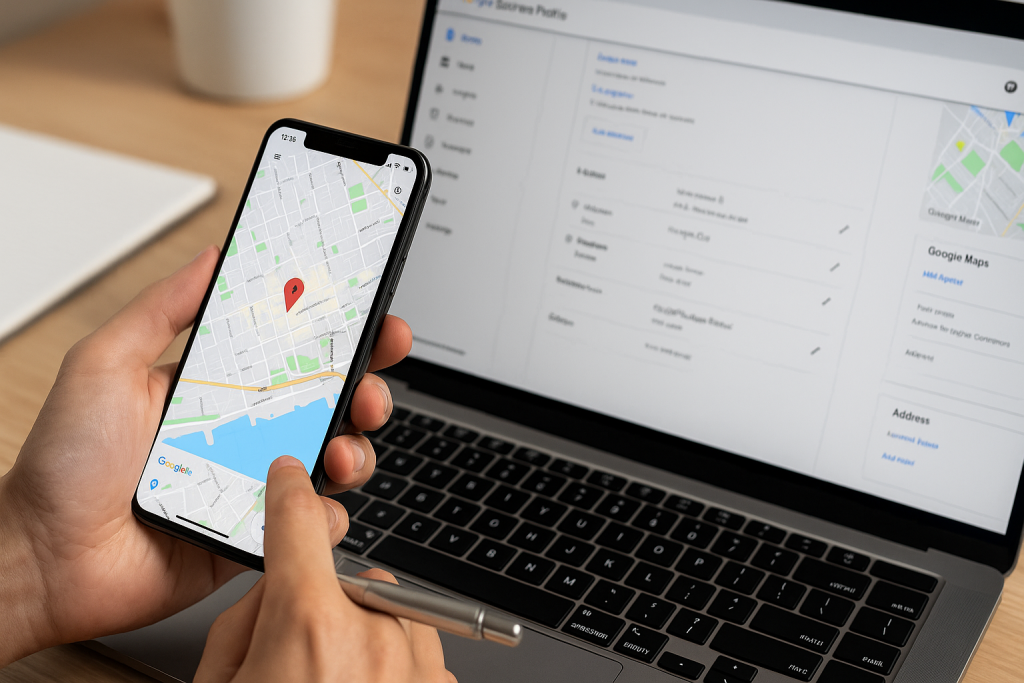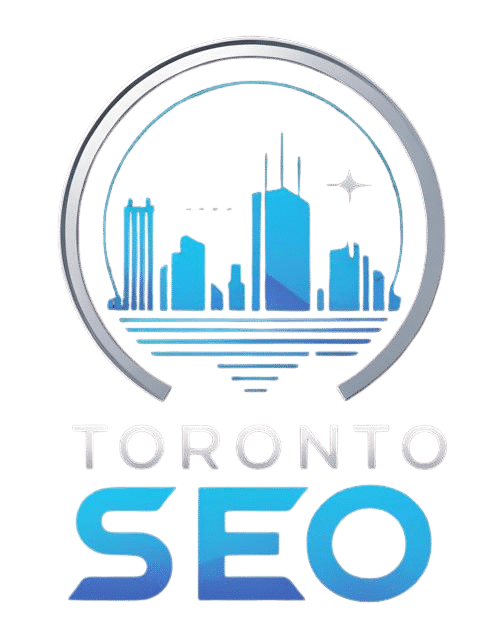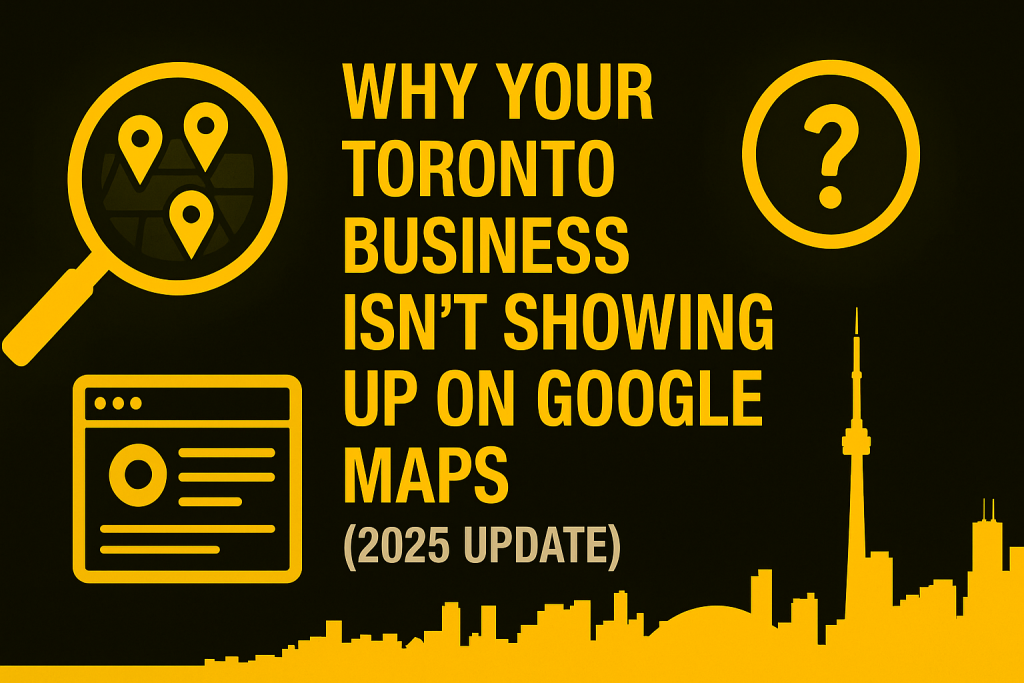The Growing Challenge of Local Visibility in 2025
If your Toronto business isn’t showing up on Google Maps, you’re not alone. Thousands of small and medium-sized enterprises (SMBs) across the GTA are struggling with this exact issue in 2025. With the latest updates to Google’s local search algorithms and the growing influence of AI-driven local ranking factors, the competition has never been tougher.
Whether you’re running a restaurant on Queen Street, a dental clinic in North York, or a real estate agency downtown, appearing in the Google Maps 3-Pack is no longer optional — it’s essential for survival in the digital marketplace.
Understanding How Google Maps Rankings Work
Google Maps rankings are based on three key pillars:
Relevance – How well your Business Profile matches the intent of the search query.
Proximity – How close your business is to the searcher’s location.
Prominence – How well-known or authoritative your business appears online.
However, in 2025, Google’s algorithms now weigh user engagement signals, AI-inferred quality, and E-E-A-T (Experience, Expertise, Authoritativeness, and Trustworthiness) metrics more heavily than ever before. That means outdated listings, inconsistent data, or low-quality content can immediately push your profile out of local visibility.
For a deeper understanding of how algorithmic changes affect rankings, check out Understanding Google’s Latest Algorithm Update.
1. Your Google Business Profile Isn’t Fully Optimized
Incomplete or inconsistent profiles remain the #1 reason Toronto businesses fail to appear on Google Maps.
Your Google Business Profile (GBP) must include:
Accurate business name, address, and phone number (NAP).
Detailed business category and services.
A compelling, keyword-rich business description.
Regularly updated photos and posts.
Verified business hours and attributes (e.g., wheelchair accessible, free Wi-Fi).
If any of these are missing or outdated, Google will deprioritize your listing. A properly optimized profile is your ticket to visibility in local searches — especially on mobile.
For advanced optimization tactics, explore Google Business Profile Toronto.
2. NAP Inconsistency Across the Web
Google cross-verifies your business information across dozens of directories and websites.
If your NAP data doesn’t match exactly — for example, “St.” vs “Street” — it can erode your credibility.
A strong citation cleanup strategy, like the ones outlined in Citation Cleanup Toronto & GTA Directory List, can help restore consistency and strengthen your ranking signals.
Tip: Always use a single source of truth for your business information (like your website footer), and keep all third-party listings synced with it.
3. Poor Review Volume and Engagement
Google Maps heavily prioritizes review quality, quantity, and response rate.
Toronto consumers trust local reviews — and so does Google. A business with 100 positive reviews and frequent owner responses is far more likely to rank higher than one with only 10 unengaged reviews.
Strategies to improve reviews:
Encourage happy customers to leave reviews with QR codes or follow-up emails.
Always respond professionally to both positive and negative feedback.
Use keywords naturally in your responses (“Thanks for choosing our Toronto dental clinic”).
Read Review Strategy for GTA Businesses to learn how to generate and manage feedback that improves local ranking.
4. Lack of Local Backlinks and Citations
Google interprets local backlinks — links from reputable Toronto-based websites — as votes of confidence for your business.
To build them:
Partner with Toronto chambers of commerce, local bloggers, or community event sponsors.
Submit to respected directories like the Canada Business Network or Ontario.ca business portal.
Collaborate with local nonprofits, schools, or news sites.
Local citations and backlinks both reinforce your business’s authenticity and physical presence in Toronto.

5. Weak Website SEO Supporting Your Profile
Even though Google Maps results are technically separate from organic results, the SEO strength of your main website still plays a crucial role.
Your site should:
Include schema markup for local businesses.
Load quickly with mobile-first optimization.
Feature location-based landing pages (e.g., “SEO Services in Downtown Toronto”).
Use internal links to reinforce relevance between pages.
Check Web Development Essentials to ensure your technical SEO and web structure align with your local goals.
6. Competitors Outranking You with AI-Driven SEO
The top-ranking businesses in Toronto have already integrated AI-powered SEO tools to track competitor movements, identify local keyword clusters, and optimize content dynamically.
If your competitors are using advanced tactics like machine learning keyword mapping or predictive SEO, your outdated manual approach won’t compete.
See Top SEO Agencies in Toronto Are Using AI to Outrank the Competition to understand how this shift is happening now.
7. You Haven’t Claimed or Verified Your Listing
It sounds simple, but hundreds of Toronto businesses still fail to verify their listings. Without verification, Google won’t display your profile in Maps.
Steps to verify:
Sign in to Google Business Profile Manager.
Claim your business via postcard, phone, or email.
Ensure ownership verification matches your registered business entity.
Once verified, Google may take up to 72 hours to reflect changes.
8. You’re Targeting the Wrong Keywords
If your listing description or website content doesn’t include geo-specific keywords, Google may not associate your business with the right region.
For example, if you own a salon in Leslieville but only use “hair salon” instead of “Leslieville hair salon” or “Toronto East hair stylist,” you’ll miss critical local search intent.
Learn how intent-based keyword research can unlock better visibility in Toronto Keyword Research: Intent First.
9. You Have Duplicate or Suspended Listings
Multiple listings under the same name or address can trigger Google’s spam detection filters. Suspended or duplicate profiles should be removed or merged immediately through the Google Business support portal.
Google’s spam policy has become stricter since 2024, automatically penalizing listings with conflicting addresses, fake locations, or mismatched categories. If your listing disappears, review Beat GBP Spam in Toronto for compliance insights.
10. You’re Ignoring Google Posts and Updates
Regularly posting updates, offers, and events to your Business Profile signals activity and relevance.
In 2025, Google’s AI rewards “living” profiles — those that consistently share local content, news, or service updates.
A simple post schedule of 2–3 posts per week keeps your business visible and gives users more reasons to engage.
11. Local SEO is Now About E-E-A-T and Trust
Toronto businesses that showcase their experience and trust signals — such as media mentions, team bios, and real customer photos — perform significantly better.
Including trust indicators like accreditations, awards, or case studies builds authority both in users’ eyes and Google’s.
For instance, E-E-A-T for Toronto SMBs: Building Trust Signals That Rank dives deeper into how small businesses can leverage credibility for better rankings.
12. You’re Not Using Analytics or Tracking Performance
Without tracking, you’re flying blind.
Tools like Google Analytics 4 and Search Console Insights let you see which keywords and areas drive engagement.
A practical guide like How to Track SEO Performance with Analytics can help you pinpoint which metrics matter for your Google Maps performance.
How to Fix Google Maps Visibility Issues in 2025
Step 1: Audit Your Google Business Profile
Ensure full accuracy, category alignment, and complete verification.
Step 2: Sync All Online Listings
Use a citation management tool or manual audit to fix NAP inconsistencies.
Step 3: Gather High-Quality Local Reviews
Encourage detailed reviews mentioning location and services.
Step 4: Optimize Website for Local Intent
Use structured data, mobile optimization, and Toronto-specific pages.
Step 5: Build Local Backlinks
Partner with trusted local sources for authority.
Step 6: Engage Weekly
Add photos, respond to reviews, post updates, and refresh content.
The Future of Local Search in Toronto
AI-driven Local SEO is evolving fast.
In 2025 and beyond, success will depend on combining automation, data analysis, and authentic engagement.
Those who adapt early will dominate the Toronto Maps Pack and build lasting digital visibility.
For more insights on AI-powered search and its effect on local marketing, explore The Future of Local SEO: How AI Helps Toronto Companies Rank in Google Maps.
Conclusion: Get Professional Help Before It’s Too Late
Competing for Google Maps visibility in Toronto now demands technical SEO expertise, AI-driven analytics, and consistent local engagement. Businesses that continue relying on outdated tactics will vanish from the map — literally.
For expert help in reclaiming your rankings, contact TorontoSEO.com today and let our specialists position your business where your customers are already looking — on Google Maps.
Frequently Asked Questions
1. How long does it take to appear on Google Maps after optimizing my profile?
Typically 2–4 weeks, depending on competition and verification delays.
2. Can I rank in multiple Toronto neighborhoods?
Yes, through multi-location SEO strategies and unique landing pages for each area.
3. Why was my business suspended from Google Maps?
Common reasons include duplicate listings, fake addresses, or violations of Google’s business policies.
4. Do paid Google Ads improve Maps ranking?
No. However, ads can increase brand visibility and indirectly improve engagement signals.
5. How often should I post on my Business Profile?
At least twice per week to stay active and maintain ranking momentum.


